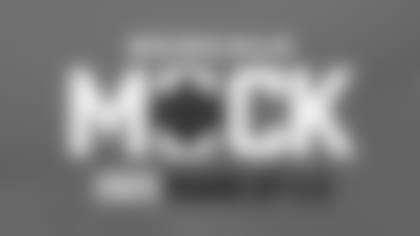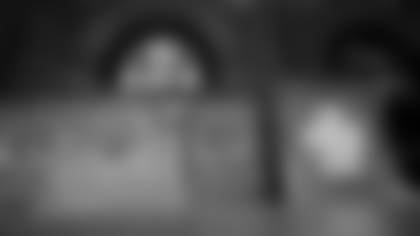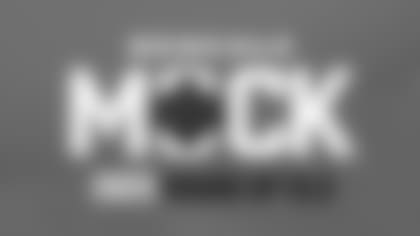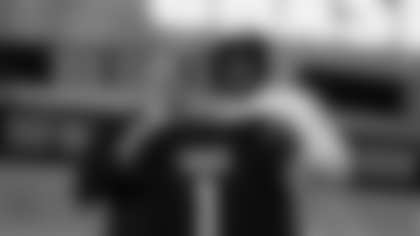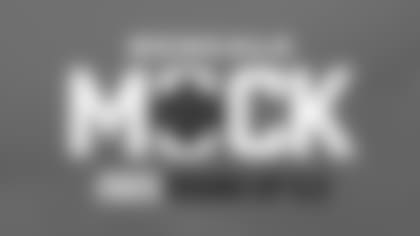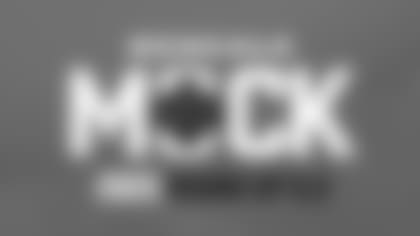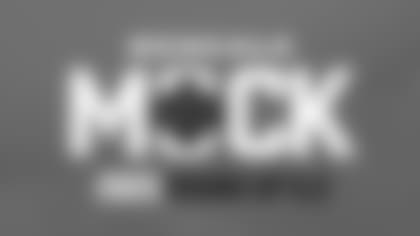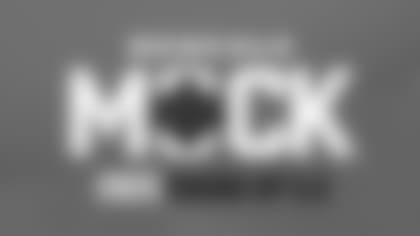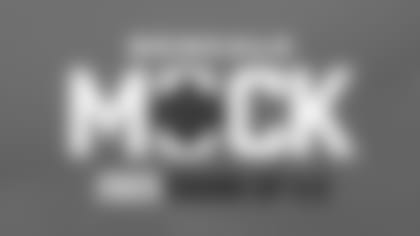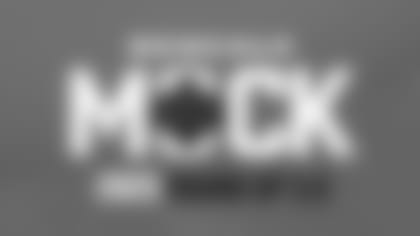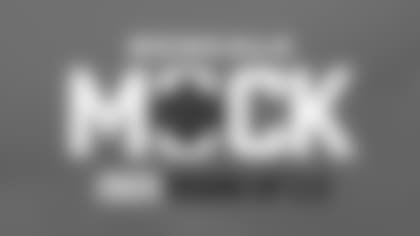In this age of pompous punditry on a landscape scattered with haters and baiters, we bring you someone completely different:
Jerry Jones.
Not that Jerry Jones, but Jerry D.S L. Jones. Jerry "The Drugstore List" Jones of the Mariemont Joneses. He's gentle and as unassuming and as in love with numbers and charts as he was nearly 40 years ago when he became one of the first draftnicks. Now you know it is spring in Cincinnati when you hear Marty Brennaman interspersed on the radio with Jerry Jones. He has recently had a chunk of cancer taken out of each of his lungs, but Jones is in front of the numbers again. He's got to have oxygen with him all the time now, but the third and final edition of his 34th draft survey, "The Drugstore List," goes to the printing press next week and he's already stockpiling for the first edition of the 35th.
"I'm an A.J. Green guy at No. 4 and go get the quarterback later. I've seen a lot of A.J. Green games down here at Georgia and I think he's worthy of a top five guy. He's Calvin Johnson. You can always get receivers, but not a guy like this."
Nowadays his printing press is the oldest of his three Apple computers in the office of his retirement home in St. Simon Island, Ga. where he's got three VCRs spinning on Saturday afternoons in the falls, as well as two DVD players. But his rankings remain as pure as the first mock draft he sketched out on a pad in the early '70s. He ranks players from rounds one to seven and free agents, breaking up the rounds with the top (A), middle (B), end (C).
As in 1-A is the best. Which happens to be how the doctors have classified his cancer. Jones, 75, ever the numbers aficionado, observes, "The lower the number and the letter, the more that is preferred."
Jones, whose hobby launched into a career when New York Times NFL writer Bill Wallace used him and two other draftnicks in a 1977 story that included the legendary Joel Buchsbaum, remains as up-to-date as Cris Collinsworth's new web site, footballpros.com, for which he writes.
The best Bengals draft pick? No doubt, he says, 1980's Anthony Muñoz, the greatest left tackle who ever lived. When the Bengals picked him third overall, the experts, including Jones, were stunned. He had more knee surgeries than games played his senior year and he only played in one: The Rose Bowl.
"I've got words of encouragement for Da'Quan Bowers," says Jones of Clemson's highly-ranked defensive end who he's got as a 1-A even though his stock is taking a hit with talk of his knee injuries. "Just look at Anthony Muñoz. He's the most prestigious Bengal of all-time. If I'm (Bowers), I wouldn't get too worked up about it."
But Jones won't delve into what he thinks is the worst Bengals pick of all-time. "That would assume I know more than these guys," he says while defending the drafting of Ohio State defensive tackle Dan Wilkinson overall at No. 1 in 1994.
"By then I was pretty tied into people around the league," he says, "and everyone else would have taken him No. 1."
Jones can talk about sitting to next to Bengals founder Paul Brown in the 1989 draft and in the next clause fret about the Bengals' present-day problems at quarterback and his belief that two quarterbacks will go in the top 10 despite their flaws. His oxygen needs oxygen after Tuesday's 68-minute phone call, which doesn't surprise WLW talkmaster Lance McAlister in the least.
"I can ask Jerry a question, get up, go get a drink, and come back," says McAlister, who has hosted him several times down through the years during draft season. "The thing about Jerry is that he has absolutely no ego. He does it as a hobby. He does it because he loves it. With some other people, you get the sense that they're trying to sell you something. Never with Jerry. And you know he doesn't have an agenda for schools, players or teams, anything like that."
"I think there will be four quarterbacks taken in the first round. Two early, two late. Cam Newton and Blaine Gabbert go in the top 10, and then I think someone is going to take a gamble on Ryan Mallett and I think Jake Locker, too, before you get to the second round."
Let's face it. Jones is a Bengals fan. He grew up in Mariemont and put his pharmacy in the town square on Wooster Pike. There was no ego on the sign out front, either, which said, "Horton's."
"Never change the sign if business is still good," he says. "I didn't have to see my name up there."
Business was always good, but the legend is that he put his two children and two stepchildren through college with the success of The Drugstore List. Not quite. Scott, his oldest at 47, an emergency room doctor in Fort Worth, Texas, put himself through Stanford Medical School.
"It helped a great deal back then, believe me, although today it would be a little different," Jones says, politely not giving up any subscription figures. "I can tell you four figures. But the heart of it is still Cincinnati."
There was a time Jones did this stuff for free and just handed it out among friends. It all literally started at the top when he and his buddy, Tom Hunter, a school guidance counselor, had dinner at The Celestial on Mount Adams the night before the 1972 draft. After they mocked out the first couple of rounds, Jones exclaimed, "Let's do the whole thing." And that's when it was 17 rounds.
"You can do that, I can't," said Hunter and his friend has been doing it ever since, which is funny because he detests mock drafts.
"One trade and the whole thing is shot," Jones says. "A couple of years later I had a friend who said to me, 'I know some guys who would be interested in these.' It turned out they were some Bengals assistant coaches."
He started from ground zero. He wrote to the colleges asking to name their top prospects and learning immediately to take their heights and weights with a grain of salt. Jones bought every magazine that had a picture of a football and worked the phone, all the while running the business and raising the kids.
*"Things don't change much from the second edition to the final. You have a case like (Arkansas tackle) Demarcus Love, who was very highly-rated earlier in the year. Then Ohio State gave him fits in the Sugar Bowl and Mallett can't move anyway. They just destroyed him, And then he didn't play well at all in the Senior Bowl and now they're wondering if he's a guard." *
Then it took off. Jones remembers Dick Forbes of The Cincinnati Enquirer being a big boost for him locally, and there was the hit from Bill Wallace, as well as a call from Tom Harmon, the Michigan Hall of Famer ("father of Mark Harmon," Jones says) to write a story for a long-forgotten publication. Then when Buchsbaum went to Pro Football Weekly, Jones went to Football News for 100 bucks a month and an advertisement trade.
Next thing anyone knew, he was on the radio with Bob Trumpy before the 1979 draft urging the Bengals to take a Missouri tight end at No. 12. Cincinnati took LSU running back Charles Alexander; the Chargers took Kellen Winslow at No. 13.
"But they did get Danny Ross in the second round," Jones says of the most prolific Bengals tight end ever.
Jones kept grinding through the '80s and the advent of the NFL scouting combine. It would take him a couple of weeks, but eventually he'd get the 40 times and the other stats from the combine, including the test scores.
"It just goes to show you," he says, "the stuff is going to leak out. If a guy like me can get it ... "
But a guy like him worked to get it. He always puts a list of people who have helped him down through the years on the back of his rankings. "They have supplied information, contacts, publicity, and confidence that keeps me working on THE DRUGSTORE LIST," Jones says.
It is a stew of Who's Who in the game. From the old personnel guys still in the gig (Pete Brown and Gil Brandt) to coaches in (Dick LeBeau) and out (Chuck Knox), and media types from Andy Furman to Len Pasquarelli, Jones makes no bones about listing who has helped him along the way.
"That's the way I was raised," he says. "I'm not deep into religion, but I'm big on God. If God did indeed create man, then the worst thing you can pull off is not treating that creation decently. You just have to be nice, that's all."
So it is no surprise, then, that McAlister, who is on the list, says he can't remember a time when he asked Jones to come on the air and he said, "Can't do it then," or "Try me later." It's always "Whenever you need me."
But you can bet every name that's helped him isn't on the list. A sleuth must have some discretion.
"Something that has really helped is the Bengals assistants," says Jones, who won't name them. "When they go to another team and I send one to them, other people ask about them and they get passed on."
Jones doesn't like to play what he calls, "The Monday morning game." He finds second-guessing a bit dishonest. He looks at the Bengals 2001 and 2010 drafts and calls them as good as you'll find. He looks at a 2006 draft of Johnathan Joseph, Andrew Whitworth, Frostee Rucker and Domata Peko, and a 2009 draft of Rey Maualuga, Michael Johnson, Kevin Huber, Morgan Trent and Bernard Scott and says, "I look at it who is still on the team and contributing and that's an impressive list. I think they draft as well as anyone."
"These guys get so wrapped up in speed. What good does it do if a guy runs a 4.35 (40-yard dash) and can't catch?"
Jones is that rare draftnick that has lived not to tell about his experiences in the war room. Before he did a radio gig with Bengals head coach Sam Wyche after the 1988 season, Wyche told him, "The old man says you can come into the room during the draft."
"Sam has been known to joke around so I called Paul Brown's office," Jones says. "Sure enough, they gave me directions to come in and park. When I walked in, Sam sat me down right next to Paul Brown. It was the single greatest moment I've ever had doing this. To be invited into the draft by Paul Brown. It was the first time I ever met him."
But Jones won't say much about it all. He's not a kiss-and-tell guy. He does allow the position coaches had a lot of pull and that Brown would end the discussions with, "Is he better than what we have?"
"Which is a pretty good way of doing it," Jones says.
Dave Lapham, the former Bengals guard and long-time radio analyst who always blows out the end to the draft season on the radio with a Jones marathon session, likes the way he does it.
"He's got his contacts, that's for sure," Lapham says. "To me, the proof is in longevity. Look how long he's been doing it. And with Jerry, his word is gold, so he's got sources that swear by him. You look at his office and all his files and you know he's legitimate."
Lapham, rated the fourth-best guard in the nation in 1974 by DSL as Jones recalls, has seen Jones's St. Simon office because Jerry and his wife Judy invited him down several years ago and they were the gracious hosts. Great restaurants. Great beach. There are pictures of family all over.
"I get suspicious of people," Jones says, "who don't have pictures of people around."
So it is no surprise that when it comes to the new breed of draftnick, Jones is kind. He respects them. He particularly thinks Mike Mayock of NFL Network is interesting.
"I respect anyone who works hard and tells the truth," he says.
Here's one truth: Jones, who retired south about a dozen years ago, invariably starts off a phone conversation inquiring about the weather in Cincinnati and then smugly gives his report.
"He's the eternal optimist; he's so upbeat," Lapham says. "I don't think he's ever had a bad day."
"The quarterback thing has me worried. But you never really know with that position. I always kidded Bucko Kilroy of the Patriots about Tom Brady. I'd ask him, 'If you knew he was so good, why did you wait until the sixth round to take him?' And he said, 'We weren't looking to take a quarterback before then.' Brady? Ironically, I had him in the sixth."
It must be spring.
Jerry is on the phone again.


